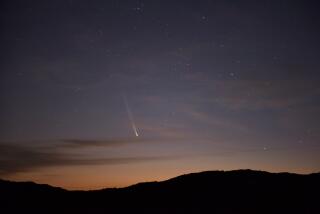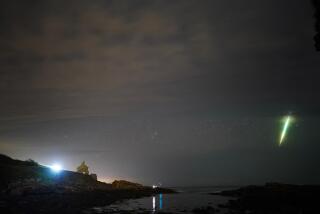Halley’s Comet--Find It if You Can
Halley’s Comet is playing cat and mouse with astronomers around the world as it cuts through the solar system at 85,000 m.p.h., and residents of Southern California have a good chance now to share a frustration known to all astronomers.
The comet is still high in the evening sky and just as bright as it has been for some time, but don’t bother looking for it now.
The moon is bright enough to wipe out any chance of seeing Halley until about Dec. 29, according to the International Halley Watch at the Jet Propulsion Laboratory in Pasadena.
The group, set up to coordinate Halley activities during its voyage around the sun, recommends that comet watchers wait until then to even try. The moon will still be bright, but it will not rise until 7 p.m, leaving about one hour of good viewing between sunset, at 5 p.m., and moonrise.
“After the 29th the moon will rise later each night, by a factor of 45 minutes to an hour, so the window will increase until mid-January when the comet will slide into evening twilight,” said Mary Firth of the International Halley Watch.
At that point the comet will be overwhelmed by sunlight, and it will not be visible again until very late in February, when it will be a morning object very low in the southeastern sky.
“But during the middle two weeks of March we will have the best viewing yet from this latitude,” Firth said. Again, it will be visible only during the early morning hours. Halley will actually be the closest to Earth in April, but it will be too low in the sky to offer much of a view from this far north.
Firth said interest in Halley is so great that two telephone numbers at JPL, which anyone can call to find how to best locate the comet, are “in almost constant use.” She said there is no way to count the actual number of callers, but she has had reports from people who frequently find the lines busy.
“One woman called saying something must be wrong because the line was busy at midnight and again at 5 a.m.,” Firth said.
COMET WATCH
The Jet Propulsion Laboratory’s International Halley Comet Watch hot lines:
Inexperienced sky observers (818) 354-4300
Amateur astronomers (818) 354-4301
More to Read
Sign up for The Wild
We’ll help you find the best places to hike, bike and run, as well as the perfect silent spots for meditation and yoga.
You may occasionally receive promotional content from the Los Angeles Times.






